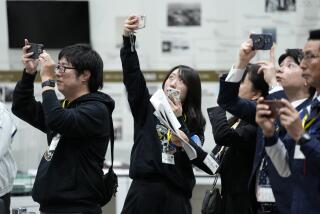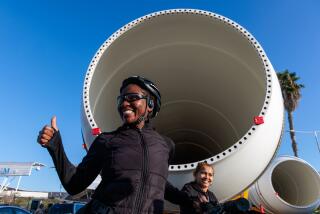Japan Rocketing Into New Market
- Share via
TANEGASHIMA, Japan — Japanese space agency officials say they are only weeks away from launching a new rocket, designed entirely with Japanese technology, that will put this country into the commercial satellite launching business.
The H-II rocket, capable of putting a two-ton payload into the kind of high geostationary orbit used for communications satellites, is scheduled to blast off from Tanegashima Space Center on Feb. 1, weather permitting.
The development of the H-II rocket, and plans for its future use, reflect the close working relationship between the Japanese government and private industry to compete internationally in cutting-edge fields.
The Japanese government spearheaded development of the new rocket through its National Space Development Agency (NASDA), at a cost of about $2.5 billion. But corporations such as Mitsubishi Heavy Industries Ltd. and Kawasaki Heavy Industries Ltd. have played a major role in building the H-II, and will participate heavily in the actual launch.
The business side of future commercial launches will be handled by Rocket Systems Corp., a private firm established in 1990 by 74 of Japan’s leading companies, including Nissan Motor Co. Ltd., NEC Corp. and Mitsubishi Heavy Industries.
Rocket Systems will accept launch orders from clients, and in turn order rockets from the companies that participated in constructing the first H-II. It also will hire NASDA to help with launches, according to Tomifumi Godai, executive director of NASDA’s Launch Vehicle Development and Operation division. NASDA is already transferring H-II technology to the private sector, Godai said.
The first rockets for commercial launch could be built in about three years, Godai said. The company has not taken any orders, however, because it lacks a launch vehicle until the H-II is a proven success.
The satellite launch business, valued at about $2 billion a year, is highly lucrative for successful players. About 60% of the world market is held by French-based Arianespace, which has launched 62 satellites on its Ariane rockets since 1980. Arianespace has a backlog of 39 satellites to be launched.
Other competing rockets are General Dynamics’ Atlas and McDonnell Douglas’ Delta. Martin Marietta’s Titan is now used primarily for U.S. military launches. China and Russia have also sought to win shares of the commercial launch business.
The 164-foot H-II, which weighs 260 tons, is a relatively “small but powerful” rocket, according to Toshihiko Kikuyama, director of the Tanegashima Space Center. “To lift the same size payload, the H-II’s overall weight can be smaller than other rockets, making the H-II more efficient.”
Technologically, the H-II should be a strong international competitor. But due to the rapid appreciation of the yen in recent years, its commercial viability is less clear.
When the H-II project was started in the mid-1980s, the aim was to be able to produce each rocket for about 16 billion yen, and that goal has basically been met, Godai said. But the cost expressed in dollars has swollen from a highly competitive $67 million to a rather expensive $145 million.
Still, Japanese companies have a strong record of devising cost-cutting efficiencies once they have mastered a technology. If the rocket proves highly reliable and launch backlogs continue at Arianespace, there could be a significant niche for Japan.
NASDA itself, which has an annual budget of about $1.6 billion, will also use the H-II rocket for Japan’s expanding space program. The next key project on the drawing boards is an unmanned space shuttle, although this has yet to receive funding approval.
“In addition to putting up satellites, we can use this rocket to carry 10-ton payloads to lower orbits where space stations operate,” Godai said. “We can carry two- to three-ton payloads to the vicinity of the moon, and we can carry slightly less than two tons to Mars.”
Development of the rocket was plagued by a series of mishaps that have delayed the first launch by two years. A technician died in a 1991 explosion during testing of an engine part. Last year, a rocket engine exploded during testing, but caused no injuries.
The February launch will be from Japan’s main space center on Tanega Island, 23 miles off the coast of Kyushu, the southernmost of Japan’s four main islands. The payload will include a satellite with monitoring equipment and an “Orbital Re-entry Experiment” vehicle dubbed OREX. Designed to splash down in the Pacific Ocean after a single orbit, OREX will test heat-resistant carbon and ceramic materials to be used in the future unmanned shuttle.
In addition to giving Japan its best vehicle yet for satellite launching, development of the H-II brings national independence to Japan’s space program. Japan’s previous best rocket, the H-I, which had a perfect launch record but is no longer in production, incorporated U.S. technology. This gave Washington a voice in how the rocket could be used.
Godai confirmed that an “important objective” in developing a rocket with purely Japanese technology was that, “if we have our own launch vehicles, we can do away with the restrictions and . . . constraints placed by other countries.”
One additional problem that must be faced before Japan can become a heavyweight in the satellite business is the interests of the fishermen of Tanega Island.
Under an existing agreement, the space agency has only two 45-day “windows” each year during which it is allowed rocket launches.
More to Read
Sign up for Essential California
The most important California stories and recommendations in your inbox every morning.
You may occasionally receive promotional content from the Los Angeles Times.










